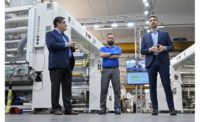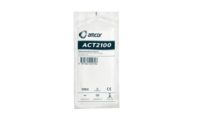Todd Blumsack
Vice President, Unit Web-Fed, Bobst North America Inc.
2 years with the company
(888) 226-8800
www.bobst.com
Giancarlo Caimmi
Commercial Director, Nordmeccanica
20 years with the company
(631) 242-98989
www.nordmeccanica.com
Q: What’s new with your company or with coating/laminating in general?
Caimmi: One year ago at Drupa 2016, we presented to the industry a new solventless adhesive lamination technology developed in cooperation with Dow. This technology became commercially available at K 2016. The technology is based on outstanding performances, such as the ability to slit the laminated compound within 90 minutes from lamination and to be food contact ready within 24-to-48 hours. The technology features incredible advantages in terms of cost reduction, energy savings and production speed. Subject production speeds have been reached at values that are well above industry standards, even when laminating high-barrier structures. Lamination quality results, both in terms of bond and optics, at those high production speeds are impressive. The patented laminator, Duplex SL One Shot, and the adhesive by Dow, Symbiex, have made great inroads within the industry in these past few months. The first One Shots have shipped and commercial installations are ongoing. The technology recently won the Technology of the Year Award 2017 at AIMCAL. Therefore, what is new in the industry is the development into a market reality of a technology recently presented to the industry. Every innovation remains within the territory of good ideas until the market, perceiving the values, makes it a reality. That happened during the first half of 2017 with this innovative combination of a new laminator and a new adhesive concept. Now, higher margins are at hand for the converter, and new territories of expansion for adhesive lamination have to be considered.
Blumsack: In terms of brand new equipment, our latest machines – the multi-technology CL 750D and the solventless SL 750D laminators – were launched a year ago. They have since been quite successful in bringing to a larger number of converters worldwide the undisputed qualities and efficiency of Bobst technology distilled into compact machines, and are especially suited to respond to the market need for shorter runs.
Something that I think is important to highlight is the extent of the collaborative activities with leading industry suppliers that take place in the Competence Center of Bobst Italia, which is Bobst’s center of excellence worldwide for gravure printing and lamination technologies. Collaboration is not new, but the extent of trials and number of projects relating to new barrier coating processes and lamination with challenging substrates for critical flexible packaging applications are going full steam and are an important part of the Center’s activity. This is alongside the testing of our equipment, be it new technology or continual incremental advances of functions and performance of existing equipment.
Q: Can you explain the big difference between solventless and solvent-based lamination? Where is coating/laminating equipment headed in this regard?
Blumsack: In terms of equipment, if the bonding agent is dissolved into solvent, the solvent carrying the adhesive needs to be evaporated in a drying oven, hence the type of adhesive used – with or without solvent – determines a different equipment configuration and different costs.
Solventless technology indeed provides some advantages, from lower capital investment and operational cost to the lower cost of adhesives, and, of course, the low environmental impact.
However, the use of solventless adhesives is constrained in the production of some high-performance flexible packaging applications, such as retort pouches, which are increasingly popular and are also being used as an alternative to canning. Such sterile packaging must undergo very rigid stress tests at increasingly high temperatures, where solventess adhesives present many limitations. Accordingly, although there is a strong preference and demand for more eco-friendly processes in the industry and among end users – thus an increase in solventess for many general purpose applications – at the same time, the requirement for high-performance food packaging applications that require sterilization for aseptic processing keeps the demand high for solvent-based adhesive lamination as well. Given the above, besides a shift away from traditional solvent-based technologies for general purpose lamination that does not require high barrier or mechanical properties, we find that the trend is to invest in multi-technology machines that enable the switch between solvent-based and solventless depending on the type of application.
Caimmi: Every coating process – whether it’s print or adhesive lamination or the like – requires a solid component of the coated compound (the resin in the case of the adhesive or the pigment in the case of inks) to be transported to the substrates through the use of a vehicle. This vehicle is a liquid that evaporates after the coating has been applied to the web. Every printer is familiar with water-based and solvent-based inks. In lamination, it is exactly the same thing. The resin – the solid component of an adhesive – is coated mixed with its vehicle, water or solvent, as a low-viscosity compound. The vehicle is eventually removed into a drying system. About 30-35 years ago, initially in Europe, a new technology in adhesive lamination was presented to the industry: solventless lamination (better defined, in technical terms as 100 percent solid adhesives lamination). As the technical definition suggests, it is a technology that does not require the resin to be diluted or dispersed into a vehicle –100 percent of what is coated is adhesive. So how does the transition of those adhesives from the fluid to the solid state work? It happens through chemistry. The adhesive is delivered to converters in two distinct components. In simple terms, it’s a resin and a hardener. The two components are inert until mixed in a proper ratio. That step is taken care of with meter mixer dispensers shortly before coating. At the time of mixing, a chemical reaction is triggered and the mixed compound becomes a solid adhesive through time. The advantages are countless. For instance, the technology does not require the use of a drying system. There is neither water nor solvent to be evaporated. The consequence is that the process is much less expansive than conventional lamination. Machines are less expansive, and the energy needed to run the process is up to 90 percent lower than the energy needed to run a dry bond lamination. There are no emissions in the process, making solventless lamination one of the most environmentally friendly among all conversion processes. Process is very much operator-friendly and very simple to learn. This last advantage played a great role in making this lamination technology one of the faster growing among all other conversion processes.
The new technology presented takes care of the inconveniences featured by traditional solventless lamination, the most significant being time. The polymerization of the mixed compound requires days before the adhesive is hard enough to allow for slitting the laminated compound. It’s not a big deal compared to the advantages of the technology. Nevertheless, it is definitely better for a converter to be able to slit within 90 minutes from lamination, to be able to measure bond within 30 minutes and to be able to judge optics results within 90 minutes. This is what the innovation is all about and this is what will define industry standards for the next decade or so.
Machinery, consequently, is heading toward allowing converters to handle more and more solventless lamination. This can be accomplished either with dedicated laminators as compact as the technology allows for or through combined laminators that allow multiple technologies to run in coating and lamination through the use of an interchangeable coating head. The near future will see more and more laminators delivered to handle the new technology we recently developed with Dow.
Q: It seems that more compact machines and solventless operations have been trending when it comes to coating/laminating equipment. Are there any other trends worth noting now? What about trends that you foresee in the future?
Caimmi: Over 25 years ago, Nordmeccanica presented to the industry the concept of compact laminators. We named it the Simplex family of products. It’s a machine configuration that revolutionized the industry and that has featured countless attempts of imitation since the early days. Pioneering the concept of compact-sized machinery was designed to work on innovative webbing concepts, introduce a number of new developments in web handling, and to maximize the use of new technologies and electronics. Nordmeccanica offered digital machine setup well in advance. The compact machine setup allowed for better web handling and to open the road to the largest market share to solventless lamination. It also led to unprecedented scrap reduction, processes to be supervised by a lower number of operators, reduced energy consumption and more.
When it comes to general trends, the zero-emission trend is prevailing. Coating is not limited only to solventless lamination, but the growing segment of EB coatings. The future conversion factory will definitely need to take into account a zero emission policy.
Q: Can you name some ways your company’s coating/laminating equipment innovations or features have helped converters over the years?
Blumsack: The integrated optimization of all the machine sections and functions, along with a no compromise approach to the technical and quality aspects of the development, enable optimum overall performance of our laminating machine. If I were to select two features that were new to the industry when Bobst introduced them in the mid-2000s and that have given a competitive edge to our customers’ operations since then, no doubt the introduction of the floating tunnel on laminating machines and the high-performance flexo coating system for coating solvent-based adhesive is still unmatched in the industry.
The performance of the Bobst Registron system for in-register cold seal or printing on pre-printed reels, is also truly remarkable in terms of quality output and reduction of waste. This is especially effective for value-added, packaging-enhancing applications for which market demand is growing. For instance, during the Open House at Bobst Italia in May 2017, a demonstration on the CL 850D laminator showed the in-register coating of a matte lacquer on a pre-laminated composite substrate, highlighting the exceptional tenure of the register system at speed variations. After a splice at full speed, the register was back, generating only 60 meters of waste!
Caimmi: Nordmeccanica made the concept of compact machinery a market reality in the early ’90s while perfecting and promoting the solventless lamination. That alone opened doors to converters for new centers of profit.
Reduced to a single item, our contribution to the industry was in fact making the conversion process for flexible packaging easier to run and more profitable. We produced high-quality, highly reliable equipment offered at very reasonable prices with the highest value for money and with flash return on investment. Think back to the conversion world before Nordmeccanica. Every machine for coating and lamination was one-of-a-kind, built completely custom even when there was no need for customization. We pioneered the integration and this allowed us to deliver highly reliable equipment, personalized to whatever level, but built out of standard components to converters.
The number of “firsts” featured in our history is very large. Our target and efforts have been directed to quality, process evolution, performance enhancement, energy and cost reduction, scrap reduction, emissions reduction and service. Just to name a few of the innovations we implemented: modular multi-layer laminators, interchangeable coating heads for machine flexibility improvement, the patented 5-rollers system for solventless adhesives coating, the labo laminator that allows virtually every adhesive manufacturer to develop state-of-the-art adhesives and coatings for our industry, the Simplex family of products, the innovative gear pumps-based meter mixer dispenser for two component solventless adhesives, the high-efficiency flat dryers, the Triplex SL One Shot for 3-ply solventless lamination and, ultimately, the Duplex SL One Shot innovation.
Solventless lamination would have never evolved to the current market share without our contribution. Adhesive lamination in general would have been a less profitable conversion process without some of the innovations we presented to the industry.
That was made with the priceless contribution of the entire value chain, but primarily thanks to the contribution of our customers, the converters. Without their support, input, feedback and without their constant raising of the bar, there would have never been the scenario we are facing today: The scenario of a growing segment of the conversion industry with high profit margins and a very bright future.
Q: What are some of the most common comments or feedback you receive from customers on your company’s coating/laminating equipment?
Caimmi: We are honored by the largest market share in the industry. The contribution of our customer to the end product through their comments and feedback is the most significant in the industry, and significant both in terms of quantity and quality. That makes for a great portion of our innovations. Some innovation is in fact homemade, like the matter of the creativity in engineering and process evolution, but the most significant innovation remains those developed to take care of specific customer-expressed needs. Therefore, we love feedback on quality and service. We consider the technological ones of primary value. Technological feedback by the end user provides the input that allows us to evolve and perfect the product, and to identify new areas of R&D. Let me use the example of the latest innovation we presented to the industry, the Duplex SL One Shot and Symbiex, the quick curing adhesive developed by Dow. It has been a customer input to trigger the R&D that eventually generated the innovation. Customers have been looking for an adhesive that allowed for immediate curing while featuring all of the best advantages of solventless lamination. When customer feedback is expressed and the value chain is there to listen, then something good will always happen.
Blumsack: The quality of output and overall operational efficiency of equipment, be it multi-technology or solventless machines.








